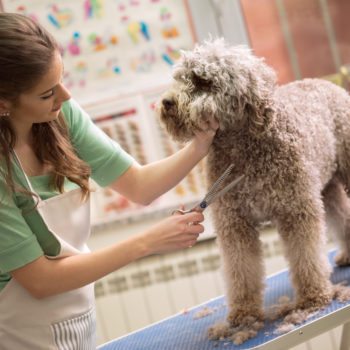Why We Love It
-
$33,600Potential Avg. Salary
-
11.1%Job Growth Rate
-
Growing DemandJob Outlook
-
Don't Take Work HomeCareer Attribute
Dog trainers are experts in managing and controlling the behaviors of dogs. They can train dogs in obedience—training puppies to respond to owner voice commands and gestures—or they may train dogs to perform service activities to assist the disabled, or help with law enforcement investigations.
Recommended Schools
What is a Dog Trainer?
The following job responsibilities are common for individuals in dog trainer roles:
- Train dogs to conduct certain actions as a result of a voice command or gesture
- Conduct obedience training for dogs to teach dogs how to behave and listen to owners
- Train dogs to provide services for humans, such as seeing-eye dogs or drug-sniffing dogs
- Train show dogs to compete in competitions
- Train dogs to perform for entertainment, including both live performances and TV/movies
A Day in the Life
Dog trainers are experts in managing and controlling the behaviors of dogs. Many dog trainers conduct obedience training for puppies and other new pets. Though dogs make excellent pets, they are innately wild animals who are driven to respond to a pack master, and dogs who do not see their owners as their pack master can be dangerous and unpredictable. Dog obedience training is crucial for any pet owners to ensure that dogs obey commands and to prevent dogs from attacking people and destroying items in a household. Obedience training may also include appropriate potty-training for puppies.
Other dog trainers teach service dogs how to perform their roles. They may train seeing-eye dogs on how to guide blind owners around busy areas, and how to keep their owners safe from harm. They may also train dogs that assist with law enforcement investigations, training dogs how to use their natural sense of smell to track criminals, sniff out drugs, find the location of explosives, or help track missing persons or discover buried bodies.
Some dog trainers teach dogs to succeed in competitions or to take on show business roles. They may train dogs to win major competitions like the Westminster Kennel Club Dog Show, or they may train dogs to appear in TV shows or movies. Shows like Lassie or movies like Old Yeller had dog trainers behind the stars of the show, training these dogs to succeed as celebrities.
Typical Work Schedule
Dog trainers usually work full-time schedules, though part-time schedules are often available as well. Many dog trainers are self-employed and are able to set their own schedules. Others work for obedience training facilities and conduct most of their work during first shift, though weekend shifts may also be required to accommodate client schedules.
Dog Trainer Specializations
- Obedience trainers teach dogs how to respond to owner voice commands and gestures to help ensure dogs that are kept as pets are well-behaved.
- Service dog trainers train dogs how to use their natural skills to function as seeing-eye companions or law enforcement animals.
- Show dog trainers train dogs how to succeed in competitions or how to perform in roles for TV shows or movies.
Typical Employers
Dog trainers may be hired by a variety of employers. They may work for obedience training facilities or for breeders who specialize in breeding service animals. They may also be self-employed and work for agencies or TV/movie production companies on a freelance basis.
Recommended Schools
How To Become a Dog Trainer
A good first step in becoming a dog trainer is to get a dog of your own and train it. To learn how to train your dog, you can engage in a number of activities. You can go to a vocational or trade school and take classes in dog training, you can read books or publications written by professional dog trainers, or you can volunteer for a dog training program at a local animal shelter. However, the best training you can get will be hands-on experience, so engaging in dog training—either professionally or personally—is a good place to start.
No formal education is required to work as a dog trainer, and experience and talent are the best ways to ensure you’re successful. If you’re having trouble breaking into the field, consider networking with other dog trainers through an organization like the Association of Professional Dog Trainers, or pursuing a national certification in dog training through the Certification Council for Professional Dog Trainers. These organizations may be able to provide apprenticeship and educational opportunities for aspiring dog trainers.
Taking an entry-level or apprenticeship position or volunteering for a local shelter are great starting points for aspiring dog trainers. Over time, you should be able to work your way into more senior-level dog training positions or even start your own dog training business.
Dog Trainer Salary Data
We’ve provided you the following to learn more about this career. The salary and growth data on this page comes from recently published Bureau of Labor Statistics data while the recommendations and editorial content are based on our research.
National Anual Salary
Low Range
$20,640Average
$33,600High Range
$57,170National Hourly Wage
Low Range
$10/hrAverage
$16/hrHigh Range
$27/hrHow do Dog Trainer salaries stack up to other jobs across the country? Based on the latest jobs data nationwide, Dog Trainer's can make an average annual salary of $33,600, or $16 per hour. This makes it an Above Average Salary. On the lower end, they can make $20,640 or $10 per hour, perhaps when just starting out or based on the state you live in.
Salary Rankings And Facts
#644 Nationally for All Careers
Programs and Degrees
Here are the most common degrees for becoming a Dog Trainer. a is usually recommended and specifically a degree or coursework that prepares you for the particular field, see below.
Highest Education Among Dog Trainers
- 1.1% Doctorate
- 3.3% Masters
- 26% Bachelors
- 8.1% Associates
- 27.3% College
- 28% High School
- 6.1% Less than High School
Job Growth Projections and Forecast
2014 Total Jobs
36,8002024 Est. Jobs
40,900Job Growth Rate
11.1%Est. New Jobs
4,100How does Dog Trainer job growth stack up to other jobs across the country? By 2024, there will be a change of 4,100 jobs for a total of 40,900 people employed in the career nationwide. This is a 11.1% change in growth over the next ten years, giving the career a growth rate nationwide of Below Average.
Growth Rankings And Facts
#159 Nationally for All Careers
What Companies Employ The Most Dog Trainers
| Industry | Current Jobs | New Jobs Needed | % Increase |
|---|---|---|---|
| Self-employed workers | 15,900 | 2,400 | 3% |
| Animal production and aquaculture | 6,200 | 500 | 1% |
| Support activities for agriculture and forestry | 4,900 | 600 | 1% |

















